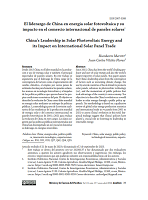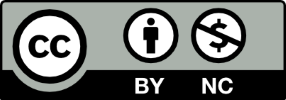China’s Leadership in Solar Photovoltaic Energy and its Impact on International Solar Panel Trade
DOI:
https://doi.org/10.32870/mycp.v13i37.870Keywords:
China, solar energy, public policy, technological innovation, exportsAbstract
Since 2015, China has been the world’s leading producer and user of solar energy and also the world’s largest exporter of solar panels. This paper argues that China’s leadership arises from the convergence of factors such as worsening climate change, the use by several countries of fiscal stimuli to promote solar panels, advances in photovoltaic technology (PV), and the momentum of public policies that took advantage of the country’s own economy. The objective is to describe China’s evolution as a world leader in solar energy through a public policy approach. The methodology is based on a qualitative review of global solar energy production statistics and international trade in pv panels from 2001 to 2021 to assess China’s evolution in this field. Empirical findings suggest that China’s policies have played a crucial role in fostering its leadership in renewable energy.Downloads
References
Bernreuter, J. (2022). Polysilicon market research. Bernreuter Research. https:// www.bernreuter.com/polysilicon/price-trend/
Best, R., Burke, P. J., & Nishitateno, S. (2019). Evaluating the effectiveness of Australia’s Small-scale Renewable Energy Scheme for rooftop solar. Energy Economics, 84(104475), 1-11. https://doi.org/10.1016/j.ene¬co.2019.104475
Bolinger, M., Seel, J., Warner, C., & Robson, D. (2022). Utility-Scale Solar: Empirical Trends in Deployment, Technology, Cost, and Value in the United States. Lawrence Berkeley National Laboratory. https://emp.lbl.gov/ utility-scale-solar/
Bradford, T. (2006). Solar Revolution: The Economic Transformation of the Global Energy Industry. The MIT Press. https://doi.org/10.7551/mit¬press/6331.001.0001
Correa, G. (2017). Cambio climático, energía solar y disputas comerciales. Portes, 11(21), 7-26. http://www.portesasiapacifico.com.mx/revistas/ epocaiii/numero21/1.pdf
Deign, J. (2022). How photovoltaic technology is changing the entire electricity system. Discover CleanTech. https://bit.ly/3M3o029
Finamore, B. A. (2020, enero). China,s Quest for Global Clean Energy Lea¬dership. IAI Papers, 20(5), 1-16. https://www.iai.it/en/pubblicazioni/ chinas-quest-global-clean-energy-leadership
Foster, R., Ghassemi, M., & Cota, A. (2009). Solar energy: Renewable Energy and the Environment. CRC Press. https://doi.org/10.1201/9781420075670
Frankel, D., Perrine, A., & Pinner, D. (2016, octubre 28). How solar energy can (finally) create value. McKinsey & Co. https://www.mckinsey.com/ capabilities/sustainability/our-insights/how-solar-energy-can-finally-create-value
Frondel, M., Ritter, N., & Schmidt, C. M. (2008). Germany’s solar cell pro¬motion: Dark clouds on the horizon. Energy Policy, 36(11), 4198-4204. https://doi.org/10.1016/j.enpol.2008.07.026
Grand View Research. (2021). Solar Energy Systems Market (Report ID: GVR- 4-68039-967-8). https://bit.ly/3nZ7KHz
Green, M. A., Dunlop, E. D., Hohl-Ebinger, J., Yoshita, M., Kopidakis, N., Bothe, K., Hinken, D., Rauer, M., & Xiaojing H. (2022). Solar cell efficiency tables (version 60). Progress in Photovoltaics, 30(7), 687-701. https://doi. org/10.1002/pip.3595
Heggarty, T., & Attia, B. (2019). Global Solar PV Markets. Wood Mackenzie. https://bit.ly/41cuQsK
Huang, P., Negro, S. O., Hekkert, M., & Bi, K. (2016). How China became a lea¬der in solar PV: An innovation system analysis. Renewable and Sustainable Energy Reviews, 64, 777-789. https://doi.org/10.1016/j.rser.2016.06.061
Intergovernmental Panel on Climate Change. (2022). Climate change 2022: Impacts, Adaptation and Vulnerability. Cambridge University Press. https:// doi.org/10.1017/9781009325844
International Energy Agency. (2022a). Renewables 2022: Analysis and forecast to 2027. IEA. https://iea.blob.core.windows.net/assets/ada7af90-e280- 46c4-a577-df2e4fb44254/Renewables2022.pdf
International Energy Agency. (2022b). World Energy Investment. IEA. https://iea.blob.core.windows.net/assets/b0beda65-8a1d-46ae-87a2- f95947ec2714/WorldEnergyInvestment2022.pdf
International Energy Agency (2022c). World Energy Outlook 2022. IEA. https://iea.blob.core.windows.net/assets/830fe099-5530-48f2-a7c1- 11f35d510983/WorldEnergyOutlook2022.pdf
International Trade Centre. (2022). Trade Map [Data set]. https://www. trademap.org/
IRENA. (2022). Renewable Energy Statistics 2022. International Renewable Energy Agency. https://www.irena.org/publications/2022/Jul/Renewa¬ble-Energy-Statistics-2022
Lens.org. (2023). Patent Statistical Database. https://www.lens.org/
Merritt, H., & Barragán-Ocaña, A. (2023). The impact of market factors on the development of eco-friendly energy technologies: the case of bioethanol. Clean Technologies and Environmental Policy, 25(2): 313-321. https://doi. org/10.1007/s10098-021-02225-6
Moskovkin, D., Mathew, A. M., Guo, Q., Eyetsemitan, R., & Daim, T. U. (2018). Landscape Analysis: Regulations, Policies, and Innovation in Photovoltaic Industry. En T. U. Daim, L. Chan & J. Estep (Eds.), Infrastructure and Te¬chnology Management (pp. 3-17). Springer. https://doi.org/10.1007/978- 3-319-68987-6_1
Ondraczek, J., Komendantova, N., & Patt, A. (2015). WACC the dog: The effect of financing costs on the levelized cost of solar PV power. Renewa¬ble Energy, 75, 888-898. https://doi.org/10.1016/j.renene.2014.10.053
Our World in Data. (2023). Solar (photovoltaic) panel prices [Data set]. https:// ourworldindata.org/grapher/solar-pv-prices
Pillai, U. (2015). Drivers of cost reduction in solar photovoltaics. Energy Economics, 50, 286-293. http://dx.doi.org/10.1016/j.eneco.2015.05.015
Rafiq, M. A., Zhang, L., & Kung, C.-C. (2022). A Techno-Economic Analy¬sis of Solar Energy Developmental Under Competing Technologies: A Case Study in Jiangxi, China. SAGE Open, 12(2), 1-15. https://doi. org/10.1177/21582440221108166
Rodríguez, M. (2012). The Social and Economic Impacts of Clean Energy Techno¬logy Exportation. IFRI Energy Center. https://bit.ly/3OtgNeC
Rúa-Ortiz, A. F., Merritt, H., & Valencia-Arias, J. A. (2020). Innovación tecnológica inducida: un análisis bibliométrico de la investigación en energía solar, 1960-2018. Análisis Económico, 35(89), 239-269. https:// analisiseconomico.azc.uam.mx/index.php/rae/article/view/497
Shah, A., Torres, P., Tscharner, R., Wyrsch, N., & Keppner, H. (1999). Photo¬voltaic Technology: The Case for Thin-Film Solar Cells. Science, 285(5428), 692-698. https://doi.org/10.1126/science.285.5428.692
Shubbak, M. H. (2019). Advances in solar photovoltaics: Technology re¬view and patent trends. Renewable and Sustainable Energy Reviews, 115(109383), 1-18. https://doi.org/10.1016/j.rser.2019.109383
Sivaram, V. (2018). Taming the Sun: Innovations to Harness Solar Energy and Power the Planet. The MIT Press.
Tetteh, N., & Kebir, N. (2022). Determinants of Rooftop Solar PV adoption among urban households in Ghana. Renewable Energy Focus, 43, 317-328. https://doi.org/10.1016/j.ref.2022.11.003
The Economist. (2018, June 16). On the solarcoaster. The Economist, 427(9096), 57-59.
The Economist. (2020, September 19). Petrostate v electrostate. The Economist, 436(9212), 22-24.
Torani, K., Rausser, G., & Zilberman, D. (2016). Innovation subsidies versus consumer subsidies: A real options analysis of solar energy. Energy Policy, 92, 255-269. https://doi.org/10.1016/j.enpol.2015.07.010
UN Comtrade Database. (2023). Trade Data [Data set]. https://comtradeplus. un.org/TradeFlow
Wiatros-Motyka, M. (2023). Global Electricity Review 2023. Ember. https:// ember-climate.org/insights/research/global-electricity-review-2023/
World Bank. (2013). China 2030: Building a Modern, Harmoniuos, and Creative Society. The World Bank. https://doi.org/10.1596/978-0-8213-9545-5
Zhang, A. H., Sirin, S. M., Fan, C., & Bu, M. (2022). An analysis of the fac¬tors driving utility-scale solar PV investments in China: How effective was the feed-in tariff policy? Energy Policy, 167(113044). https://doi. org/10.1016/j.enpol.2022.113044
Zhang, F., & Gallagher, K. S. (2016). Innovation and technology transfer through global value chains: Evidence from China’s PV industry. Energy Policy, 94, 191-203. https://doi.org/10.1016/j.enpol.2016.04.014
Zhi, Q., Sun, H., Li, Y., Xu, Y., & Su, J. (2014). China’s solar photovoltaic policy: An analysis based on policy instruments. Applied Energy, 129, 308-319. https://doi.org/10.1016/j.apenergy.2014.05.014

Downloads
Published
Versions
- 2023-12-15 (2)
- 2023-12-15 (1)
Issue
Section
License
Copyright (c) 2023 México y la Cuenca del Pacífico

This work is licensed under a Creative Commons Attribution-NonCommercial 4.0 International License.
Open Access Policy
This journal provides open access to all its contents, in adherence to the principle that making research freely available supports a greater global exchange of knowledge.
MyCP is licensed under a Creative Commons Attribution-NonCommercial license, also known as CC BY-NC.
Contents are published in both PDF and XML formats.
Authors who publish in México y la Cuenca del Pacífico must accept the following conditions:
Pursuant to Mexican copyright laws, México y la Cuenca del Pacífico acknowledges and respects the authors’ moral right and ownership of property rights, which will be assigned to the University of Guadalajara to publish the articles in an open-access mode.
México y la Cuenca del Pacífico does not charge the authors any fees for receiving and processing their articles.
Authors are permitted to enter into other independent and additional contractual agreements for the non-exclusive distribution of the article version published in México y la Cuenca del Pacífico (for example, publishing it in an institutional repository or in other printed or electronic media) as long as they clearly state that the piece was originally published in México y la Cuenca del Pacífico.
Pursuant to the above, once the article is approved for publication, authors must send the Assignment of Rights Agreement form duly filled and signed. This form must be sent to mexicoylacuenca@gmail.com as a PDF file.
Readers/users of México y la Cuenca del Pacífico can freely access the journal new issues as soon as they are uploaded. Readers/users are allowed to cite, share (both electronically and physically), print and distribute the material, provided they expressly state that the work was originally published in México y la Cuenca del Pacífico. Contents are to be properly cited and never for commercial purposes.




